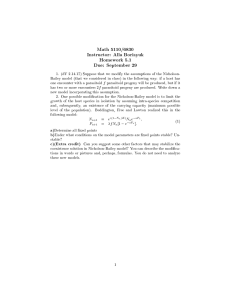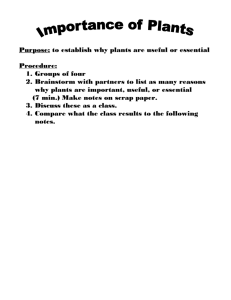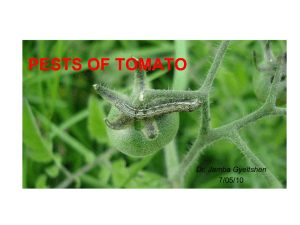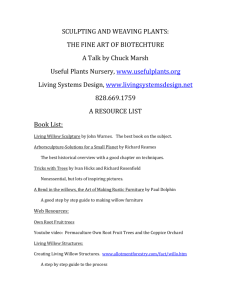No. 263, December 2015–January 2016 ISSN 1175-9755
advertisement
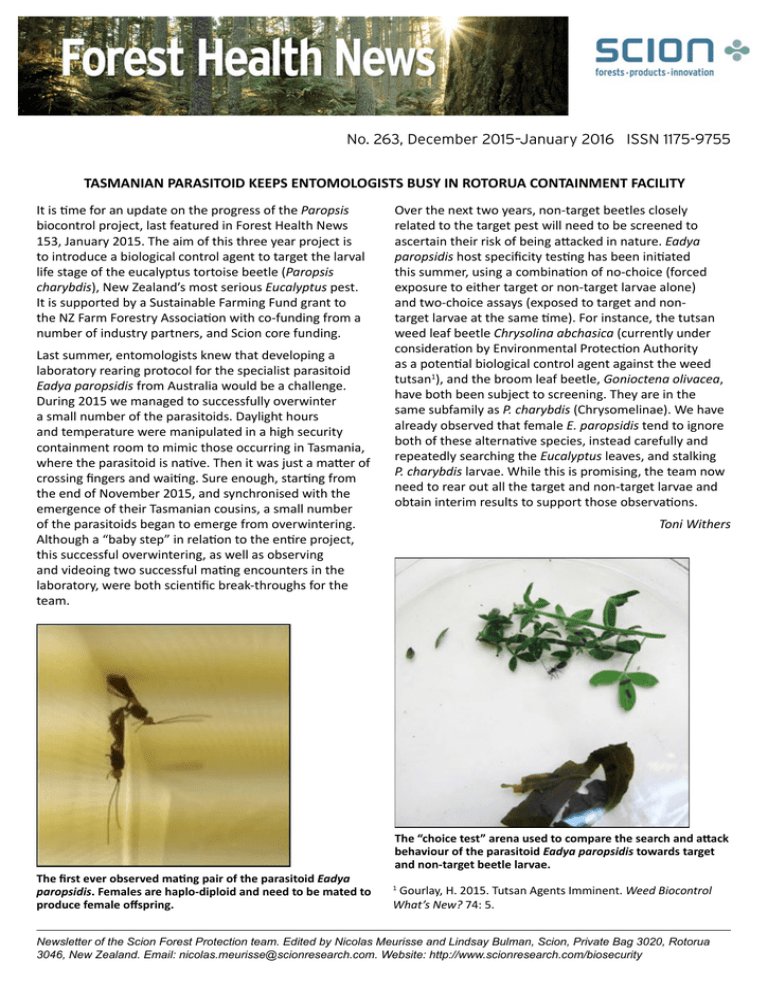
No. 263, December 2015–January 2016 ISSN 1175-9755 TASMANIAN PARASITOID KEEPS ENTOMOLOGISTS BUSY IN ROTORUA CONTAINMENT FACILITY It is time for an update on the progress of the Paropsis biocontrol project, last featured in Forest Health News 153, January 2015. The aim of this three year project is to introduce a biological control agent to target the larval life stage of the eucalyptus tortoise beetle (Paropsis charybdis), New Zealand’s most serious Eucalyptus pest. It is supported by a Sustainable Farming Fund grant to the NZ Farm Forestry Association with co-funding from a number of industry partners, and Scion core funding. Last summer, entomologists knew that developing a laboratory rearing protocol for the specialist parasitoid Eadya paropsidis from Australia would be a challenge. During 2015 we managed to successfully overwinter a small number of the parasitoids. Daylight hours and temperature were manipulated in a high security containment room to mimic those occurring in Tasmania, where the parasitoid is native. Then it was just a matter of crossing fingers and waiting. Sure enough, starting from the end of November 2015, and synchronised with the emergence of their Tasmanian cousins, a small number of the parasitoids began to emerge from overwintering. Although a “baby step” in relation to the entire project, this successful overwintering, as well as observing and videoing two successful mating encounters in the laboratory, were both scientific break-throughs for the team. The first ever observed mating pair of the parasitoid Eadya paropsidis. Females are haplo-diploid and need to be mated to produce female offspring. Over the next two years, non-target beetles closely related to the target pest will need to be screened to ascertain their risk of being attacked in nature. Eadya paropsidis host specificity testing has been initiated this summer, using a combination of no-choice (forced exposure to either target or non-target larvae alone) and two-choice assays (exposed to target and nontarget larvae at the same time). For instance, the tutsan weed leaf beetle Chrysolina abchasica (currently under consideration by Environmental Protection Authority as a potential biological control agent against the weed tutsan1), and the broom leaf beetle, Gonioctena olivacea, have both been subject to screening. They are in the same subfamily as P. charybdis (Chrysomelinae). We have already observed that female E. paropsidis tend to ignore both of these alternative species, instead carefully and repeatedly searching the Eucalyptus leaves, and stalking P. charybdis larvae. While this is promising, the team now need to rear out all the target and non-target larvae and obtain interim results to support those observations. Toni Withers The “choice test” arena used to compare the search and attack behaviour of the parasitoid Eadya paropsidis towards target and non-target beetle larvae. Gourlay, H. 2015. Tutsan Agents Imminent. Weed Biocontrol What’s New? 74: 5. 1 Newsletter of the Scion Forest Protection team. Edited by Nicolas Meurisse and Lindsay Bulman, Scion, Private Bag 3020, Rotorua 3046, New Zealand. Email: nicolas.meurisse@scionresearch.com. Website: http://www.scionresearch.com/biosecurity Forest Health News 263, December 2015–January 2016 Waikato university students Mike Davy and Elise Peters’ participation in the biocontrol programme is a big step up from the three-hour controlled lab sessions they have each week at university. Their work includes foliage collection for the beetles to eat, larvae growth monitoring and recording attack data from the Tasmanian parasitoid wasp. This work needed to continue over the Christmas break. are prized as key early season pollen and nectar resources for honey bees, among their many other uses such as flood protection and land stabilisation. Concerns from these various interest groups have led to scientists and bee industry players collaborating on a Sustainable Farming Fund bid. In the meantime, Julia is travelling weekly to a Bay of Plenty Regional Council willow nursery in Whakatane, where she is attempting to make the link between aphid abundance and levels of cement honey being produced in nearby bee hives. The hives have been kindly provided by Golden Grove Apiaries. Stephanie Sopow and Julia Martin MONITORING GIANT WILLOW APHID ABUNDANCE IN THE BAY OF PLENTY Bay of Plenty Polytechnic student Julia Martin, hosted at Scion this summer, is developing methods to monitor the seasonal abundance of the recently introduced giant willow aphid, Tuberolachnus salignus (FH News 246 and 248). The giant willow aphid feeds on the sap of willow trees and, during this process, excretes copious amounts of honeydew that is readily gathered by honeydew feeders such as bees and wasps. Stephanie Sopow, Julia Martin and John McLean sampling honey. One of the indicators of giant willow aphid population levels being trialled is the use of water-sensitive cards placed under infested trees. After only a short period of time “aphid art” is created by splatters of the honeydew falling on the cards, for which the area covered will be calculated. PREETI PANDA Giant willow aphids. For apiarists, the “honeydew honey” that bees produce from this honeydew presents several problems. This type of honey is often referred to as “cement honey”. The sugars have low solubility and much of the honey crystalizes in the comb, making the extraction process difficult and thereby reducing yield. In addition, the jury is still out on whether the qualities of this type of honey are desirable to humans or not, and whether it provides good quality food for the bees for their winter survival. Feeding by the giant willow aphid is also expected to negatively affect the health of its host trees, primarily willows (Salix spp.), as has been shown elsewhere. Willows Preeti Panda has recently joined Scion’s Forest Protection team. She will be working on interactions of Phytophthora species on radiata pine and kauri under the Needle Disease and Healthy Trees Healthy Future programmes. After completing an MSc in Biotechnology from Abertay University in Dundee (Scotland), Preeti moved to New Zealand and completed a PhD in plant protection at Lincoln University. Her thesis project involved comparative genomics to identify candidate virulence genes and other regions of interest acquired by horizontal gene transfer that cause disease on tubers and stems of potato plants. Preeti used various mutagenesis techniques for functional characterisation of these virulent genes. Nicolas Meurisse Printed by Scion Digital Print Centre, Rotorua (07 343 5711)



